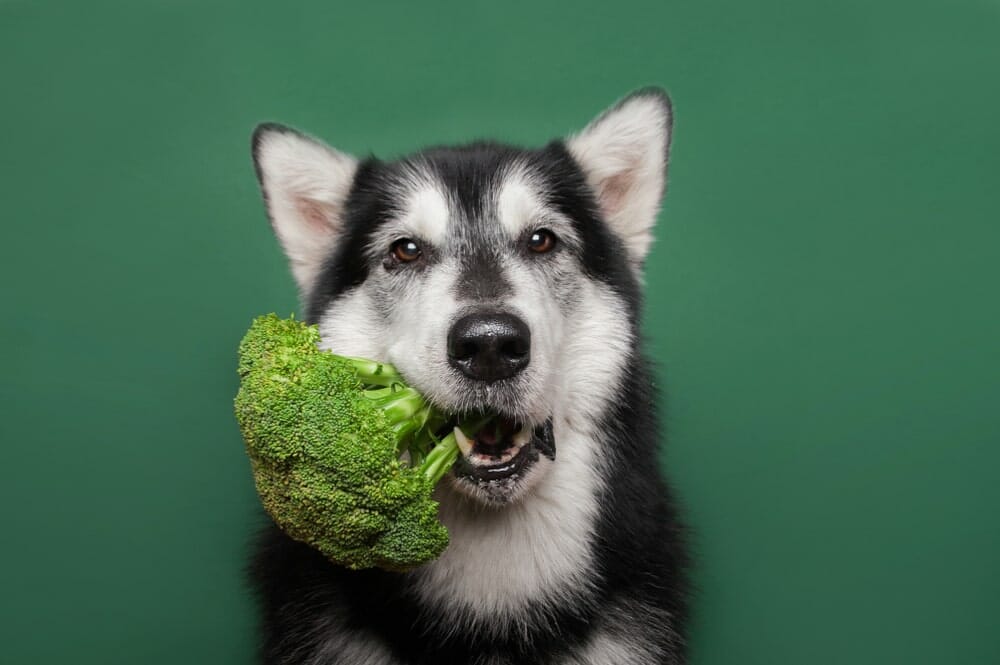Last updated: July 27, 2022
As omnivores, dogs can eat meat and plants, including vegetables. But what vegetables can dogs eat?
As a responsible pet parent, you must know what’s safe and unsafe when it comes to giving your furry friend people food. Dogs have different digestive systems to humans, and the things we can eat aren’t always safe for canine consumption.
Most dogs enjoy eating things they’re not supposed to, so you must always be vigilant and in the know. Some vegetables can be difficult for your pup’s digestive system to process, while others contain chemicals and acid that can damage your dog’s nervous system and organs.
With these revelations, it’s only natural to wonder what veggies are good for dogs and if dogs can eat raw vegetables.
There’s a good chance your dog may encounter a vegetable at one point or another, whether it’s from your plate, vegetable garden, or the trash bin! Knowing what vegetables are safe for dogs and which ones require some attention when ingested is a good idea.
Read on for a closer look at the vegetables your dog can enjoy, what vegetables are bad, the benefits of vegetables for your dog, and a safe treat option from Spot and Tango that will introduce vegetables into their diet in a safe way.
What Vegetables Can Dogs Eat?
Here’s a complete list of vegetables your dog can eat and even enjoy:
Carrots
Dogs are big carrot fans. If you’re wondering what vegetables are best for dogs or what raw vegetables can dogs eat, try carrots.
They’re crunchy, sweet, and fun to chew on, making them a great snack fido can enjoy fresh, cooked, or frozen. Carrots are low in calories and rich in fiber, vitamins B, C, D, E and K.
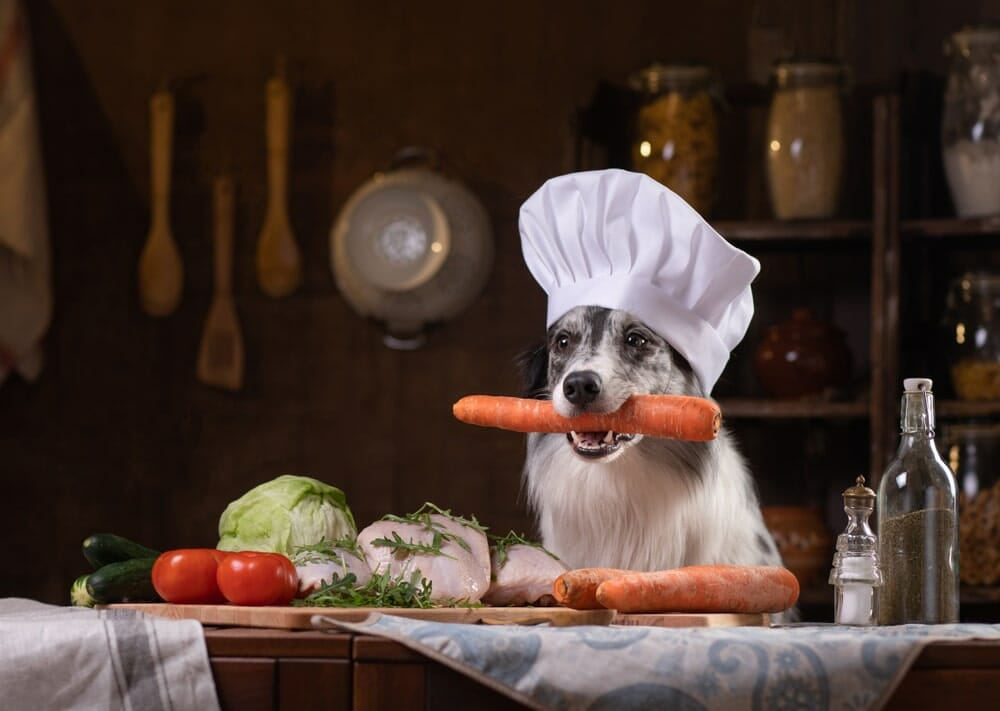
Carrots are hard and fibrous when eaten raw, so they can help in keeping your dog’s teeth clean. Ensure you cut the carrots down to a smaller size or blend them so they’re easy to digest and don’t present a choking hazard.
Cabbage
Cabbage contains phytonutrients and vitamins B1, B6, C and K that help improve your dog’s overall health. Only feed cabbage in moderation, as it can make your pet gassy.
Red cabbage can also help boost your pet’s copper, fiber, potassium, and manganese levels. Avoid feeding raw cabbage in large amounts, as it contains thiocyanate, which can lead to hypothyroidism.
Broccoli
Broccoli delivers tons of fiber, vitamins A, C, E and K, and is low in fat. It’s safe for dogs to eat but should only be served in small amounts as an occasional treat, no more than once or twice per week.
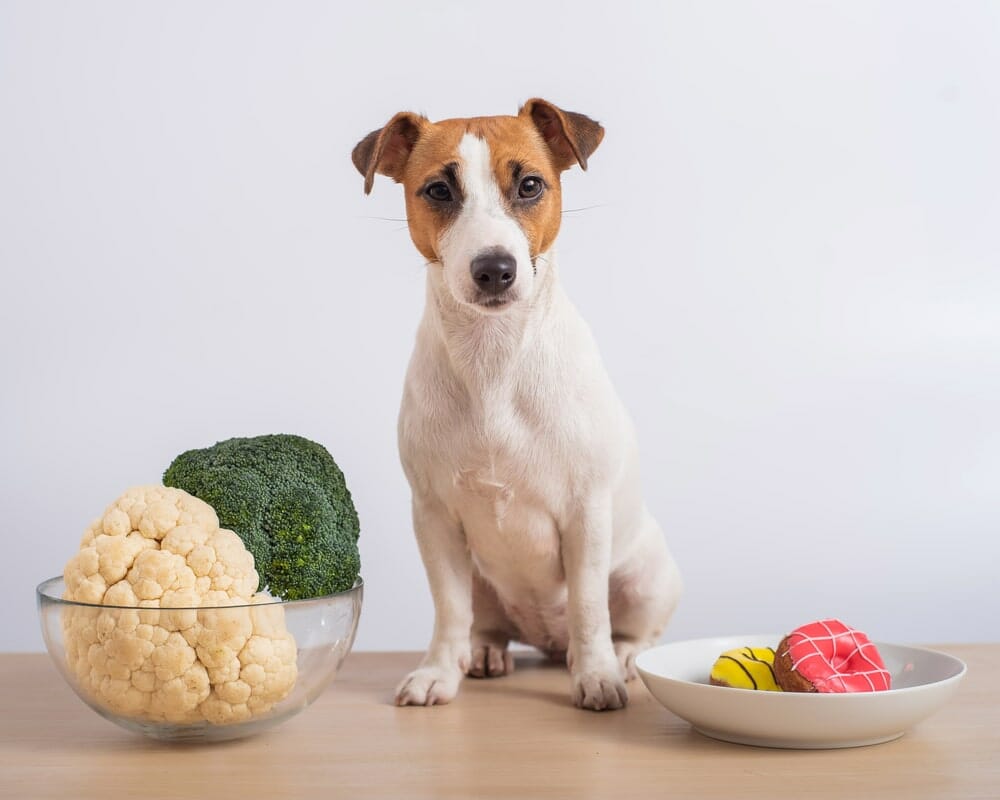
Broccoli can result in a smelly experience for you and your furry friend. The vegetable’s florets contain isothiocyanates which can cause mild to severe gastric irritation in some dogs, so caution is warranted.
Celery
Celery is among the best. It works overtime to bring great benefits to your dog. Celery is rich in vitamins A, B, C and K, manganese, and potassium.
It can boost your dog’s eyesight and will go above and beyond to freshen their breath as they chew on its crunchy texture. It’s also low in calories and a natural diuretic.
Cauliflower
Cauliflower is safe for your dog in small quantities only as it can lead to uncomfortable gas, just like other cruciferous vegetables.
Cauliflower provides your dog with biotin, omega-3 fatty acids, phosphorus, vitamins B, K and C, and manganese. It’s low in calories and great for your dog’s immune system. It’s best served lightly steamed or cooked.
Green Beans
One of the best answers to what raw vegetables can dogs eat is green beans. They’re crunchy with a natural sweetness that makes them a palatable choice.
They’re safe to serve raw, steamed, or canned, provided they’re plain and unsalted. Green beans are low in calories and loaded with fiber, vitamins A, B6, C and K, calcium, and iron, promoting red blood cell production.
Cucumbers
When it comes to veggies that can be eaten every day, the answer is cucumber. Cucumbers are an ideal snack for dogs who need to avoid excess sugar, fat, or calories. Cucumber is low in calories but can boost your dog’s energy and keep them hydrated, thanks to their high water content.
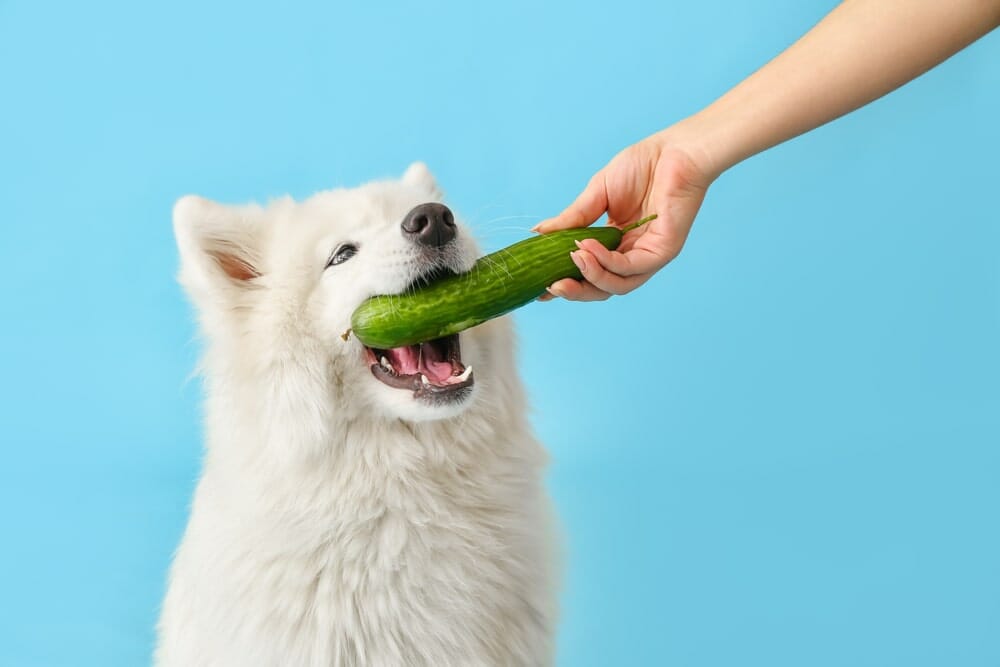
In addition to helping your pup stay refreshed, cucumbers also pull their weight in nutritional value. They contain vitamins B1, C and K, copper, potassium, biotin, and magnesium.
Potatoes
Potatoes are safe for dogs, but only if boiled, baked, or steamed and served plain. You should avoid giving your pet French fries because of the high-fat content. Never give your dog raw potatoes, as they contain solanine, which can be toxic to dogs.
Sweet Potatoes
Sweet potatoes are nutrient-dense and provide a range of benefits for your dog. They contain tons of fiber, vitamins B6 and C, and beta-carotene that is good for your dog’s sight and skin.
You should only serve plain sweet potatoes that are boiled or baked, as you would with regular potatoes.
Pumpkin
Are you asking yourself what vegetables can dogs eat to alleviate health issues? Try pumpkin! According to this past Spot and Tango article, it’s one of the best vegetables for dogs and is often used to help pups deal with diarrhea or constipation. Pumpkins are high in fiber and full of vitamins A, B, C, and E.
Pumpkin is low in calories and tasty. Ensure you only feed your dog 100% pure pumpkin and not pumpkin pie to avoid additives or sugar. The seeds are also safe for your dog, provided they’re plain and free of sugar, oil, or salt.
Brussels Sprouts
Brussels sprouts contain vitamins K and C, which help boost your dog’s bone health and immunity. They’re also filled with fiber, folate, and antioxidants that prevent inflammation.
They’re best served cooked and in moderation to ensure your dog doesn’t get gassy.
Beets
Beets contain vitamin C, fiber, potassium, manganese, and folate. They can benefit your dog’s digestive and immune systems. You can serve them cooked or raw, provided you chop them up to avoid the risk of choking.
Give beets only a few times a month since they can increase the risk of bladder stones. Canned beets may also have high sodium levels.
What Vegetables Are Bad For Dogs?
Never feed your dog any of the following vegetables:
Onions
Onions are toxic to dogs, and your pup should never have access to them. If your dog experiences a sudden decrease in energy, starts vomiting, or has dark yellow urine or unusual bowel movements, your dog may have eaten onions. Contact your vet immediately.
Garlic
Like onions, garlic is also toxic to dogs and can cause diarrhea and vomiting if ingested in small amounts. It contains a compound that reacts badly with your dog’s system, and even a sizeable amount can result in anemia, weakness, energy loss, and jaundice.
Mushrooms
Wild mushrooms are very toxic to dogs, and you should never serve them. Store-bought mushrooms are generally safe for your dog to eat, provided you serve them plain and in small amounts. You should call your vet immediately if your dog ingests a wild mushroom.
Tomatoes
Ripe tomatoes are generally safe for dogs, but you must be vigilant if you have a vegetable garden with tomatoes. Unripe tomatoes, together with the leaves and stems of the plant, are toxic to dogs. These parts contain high amounts of solanine, a poisonous chemical that can cause tremors and seizures.
Benefits Of Vegetables For Dogs
While your dog doesn’t necessarily require vegetables to meet its nutritional needs, veggies provide beneficial nutrients and vitamins. Vegetables make healthy, low-fat treat replacements and meal toppers, which can be especially helpful if your dog needs to lose weight.
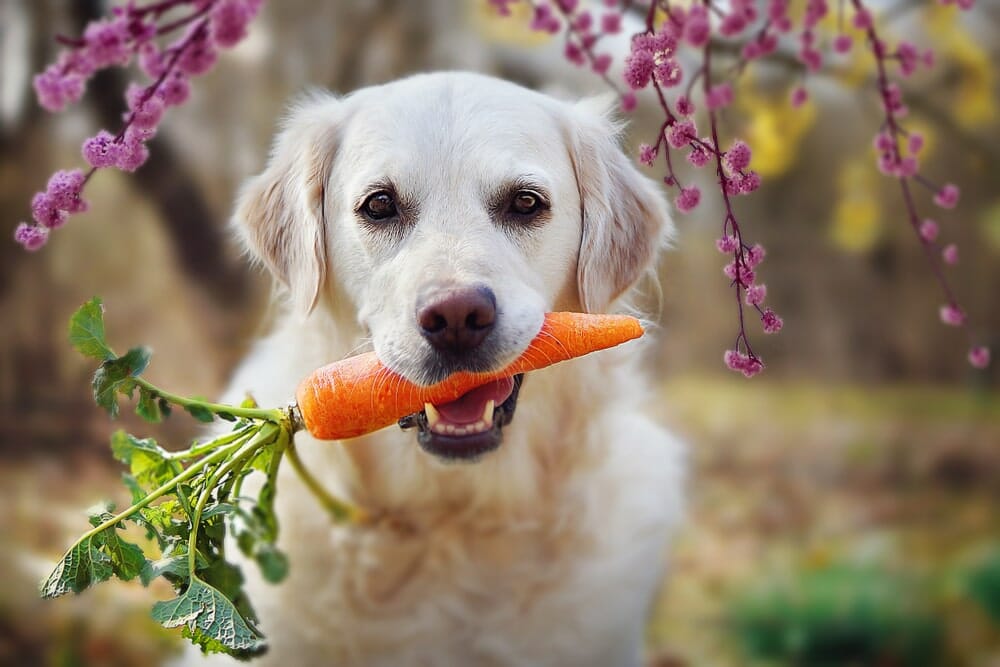
Vegetables provide your dog with fiber, antioxidants, and other plant-based compounds that can help fight diseases. In fact, studies show that the consumption of certain vegetables can slow or prevent the development of cancer in some dogs. Veggies also contain enzymes that aid your dog’s digestion. Thanks to their high-water content, they are an excellent source of hydration and can be a fantastic treat if you live in a hot climate.
Your vet may recommend switching your dog’s regular treats with vegetable snacks like carrots if your dog needs to maintain a healthy weight. Thankfully, Spot and Tango incorporate vegetables into their wet and dry dog food options to make your job easier.
Safe Treat Option for Your Dog
Spot and Tango champion healthy pups by ensuring they eat vegetables as part of their diet. They guarantee safe and wholesome treats for your dog by creating dry and wet dog food that’s good enough for humans to eat.
All Spot and Tango recipes contain vegetables. That includes the Spot and Tango Beef and Millet meal, which has an incredible flavor and aroma and contains spinach, carrots, peas, parsley, and cranberries.
These healthy ingredients contain vitamins C, K1 and E, and manganese, and are full of antioxidants and fiber that support your dog’s immune system, gut, brain, and urinary health while preventing cancer, joint pain, and heart disease.
All meals are cooked to order, packaged, frozen to preserve freshness, and delivered to your doorstep within days of being made. Veterinary nutritionists formulate the meals to meet and exceed AAFCO nutrition levels for all stages of life, ensuring the meal is complete and balanced.
Spot and Tango meals remain fresh and healthy for extended periods in your freezer without fillers, preservatives, or additives. Simply defrost the meal when it’s time to feed your pet and serve.
You can also try Spot and Tango’s Unkibble, which brings you the benefits of a fresh diet in a dry format. This vet-developed innovation from Spot and Tango combines fresh meat, veggies, and fruits in a unique Fresh Dry process to maximize nutritional integrity.
UnKibble recipes like Cod and Salmon feature pumpkin, sweet potatoes, carrots, spinach, parsley, and strawberries. Unlike other dry foods, Spot and Tango’s UnKibble uses 100% fresh, human-grade ingredients, with no sweeteners, preservatives, additives, or fillers.
Try these recipes today, and you’re guaranteed a full refund if your dog doesn’t like them!
How To Feed Vegetables To Your Dog
Like all other foods, it’s best to introduce vegetables slowly into your dog’s diet. Give small amounts and observe how your dog reacts. If they’re not affected adversely, you can gradually increase the quantity.
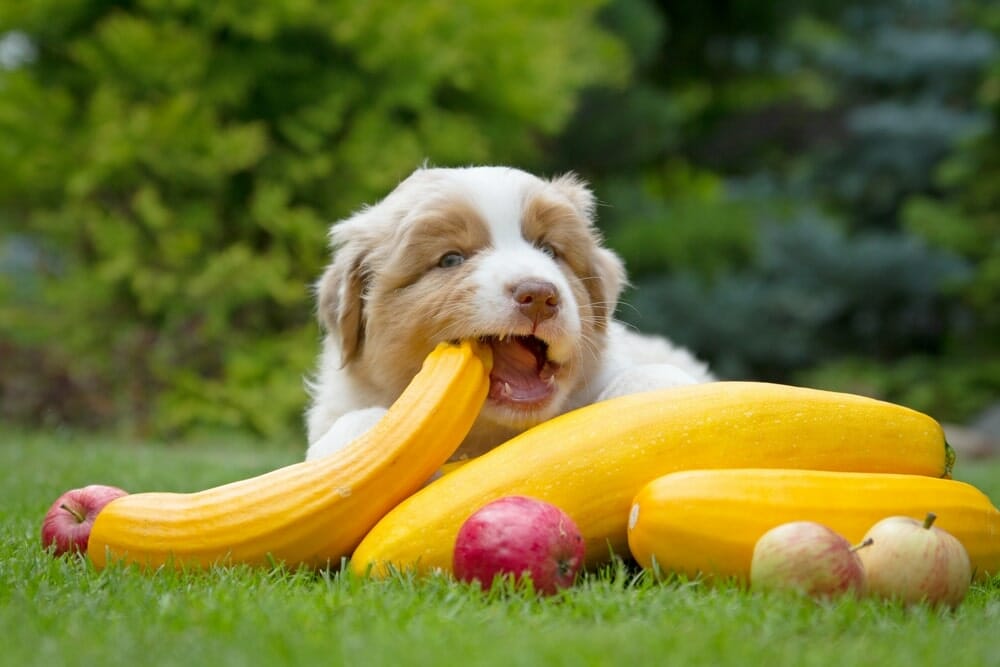
Ensure you cut or chop the vegetables into bite-sized pieces to reduce the risk of choking. Serve them plain and free of additives, salt, oils, or spices that can harm your furry friend and destroy the nutritional value of the vegetables.
Cooking the veggies can make them easier for your dog to eat and digest. Just remember, vegetables should be given as an occasional snack or treat. They should never make up over 10% of your dog’s daily calorie intake.
Frequently Asked Questions
Can Dogs Eat Dried Vegetables?
Yes! You can safely add dried vegetables like carrots, green beans, sweet potatoes, or broccoli into your dog’s food. You can freeze them to create a refreshing, healthy treat for hot summer days.
What Vegetables Can Puppies Eat?
The vegetables listed above as safe for dogs are also suitable options for your puppy. These veggies can make healthy treats for young dogs, provided they’re finely cut, cooked or steamed, and served without additives. Ensure you only give them as treats occasionally ‒ they should never make up over 5% of your pup’s diet (for adult dogs it’s 10%).
It’s also wise to consult your vet before adding new food items to your puppy’s diet, including dog-safe vegetables.
What Is The Best Vegetable For A Dog?
The above vegetables are some of the best veggie options for your dog. Although your dog can’t go full vegetarian, these veggies are packed with vitamins, minerals, antioxidants, and fiber that can aid your dog’s immune system and make them healthier.
Veggies are generally high in water and low in calories and fat, making them excellent replacements for regular treats. Some veggies can even help keep cancer at bay in dogs.
Conclusion
So, what vegetables can dogs eat? What are the best vegetables for dogs?
Carrots, green beans, cabbage, celery, cauliflower, broccoli, cucumber, sweet potatoes, and pumpkins are all excellent options. Make sure to avoid harmful options like onions, garlic, mushrooms, and tomatoes to keep your dog safe.
Remember you can create your meal plan on Spot & Tango website and adapt it to your dog’s needs. If your dog is allergic or sensitive to some specific food, please mention it and we will make sure to suggest alternatives that will keep his/her tummy satisfied.


